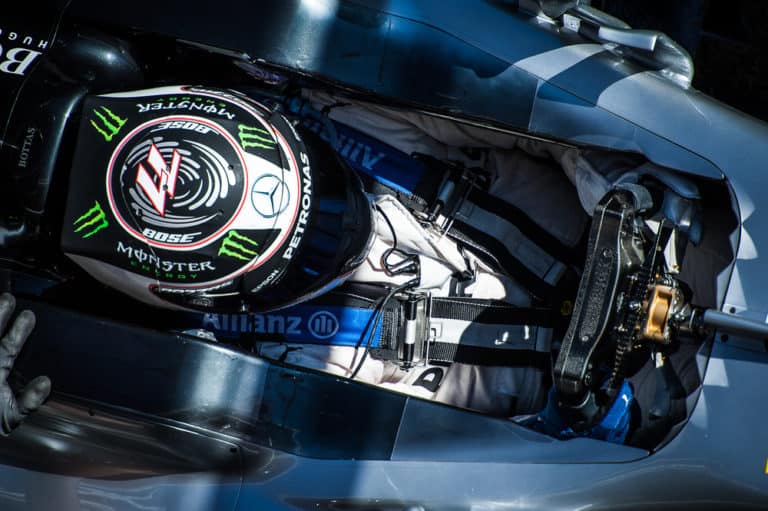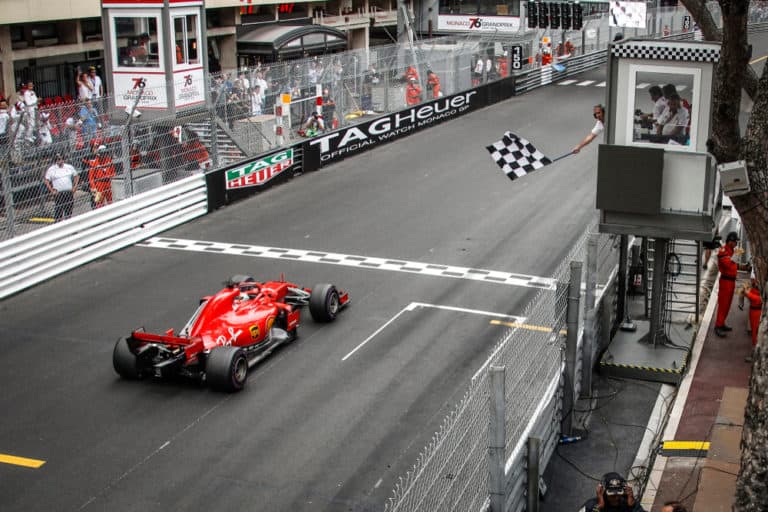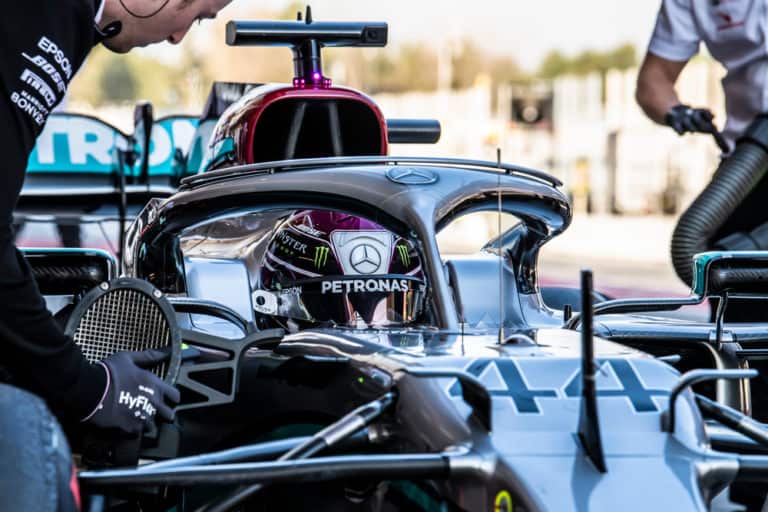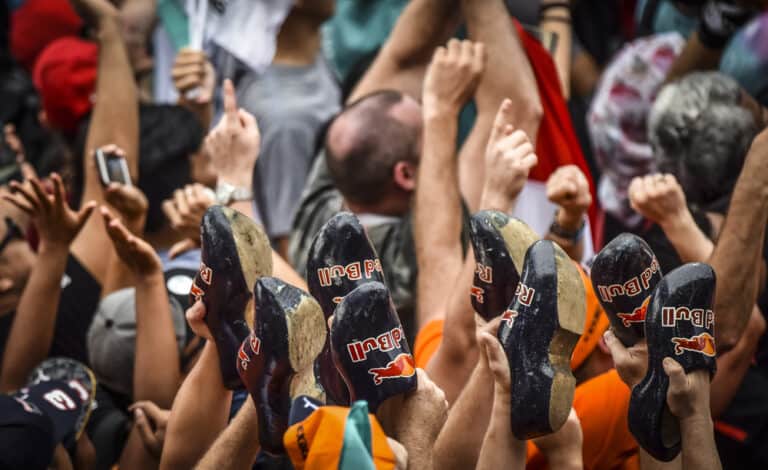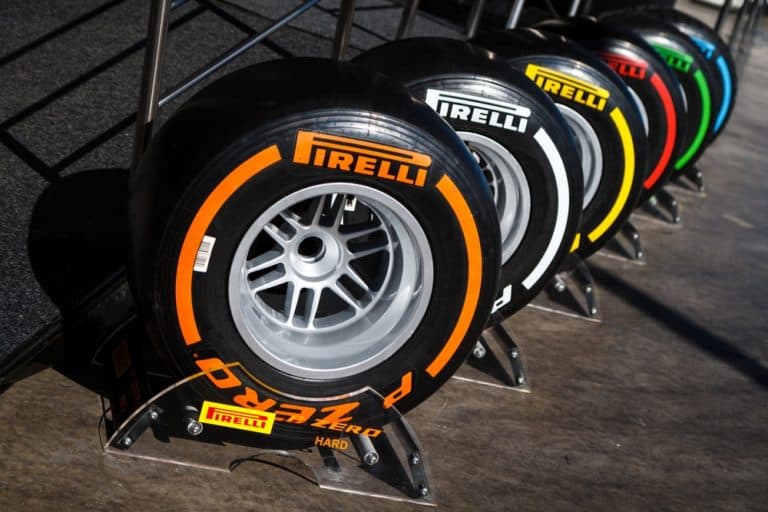Editorial credit: Ev. Safronov / Shutterstock.com
In Formula 1, wind and its behavior with the car are fundamental. This makes F1 broadcasts talk a lot about aerodynamic concepts that are sometimes difficult to understand. One of the most talked about is the Coanda effect, but what is it really?
The Coanda effect is the tendency of air to remain attached to the surface it flows over, adapting to that solid and following its contour due to the viscosity of the fluids. F1 aerodynamic engineers play with this effect to make the airflow follow the car’s contour.
Despite its simple definition, in Formula 1, it can be used in many ways, significantly affecting car performance depending on how it is understood and applied. Read on to discover what it is, how it works, and why the Coanda effect occurs in F1.
What Is Coanda Effect?
The Coanda effect is a physical phenomenon that occurs in any fluid, as it tends to be attracted by a surface neighboring its trajectory. Air, and any other fluid, have a certain friction, called viscosity, which varies from one to another. Thus, the Coanda effect is produced by the fluid’s viscosity, which tends to adhere to a curved surface, modifying its trajectory.
For the fluid (in our case, air) to adhere, it must be a rounded surface without abrupt changes. For example, the air will not adhere in the case of a cube, as it will hit the flat surface and slow down, detaching itself from the surface. In the case of a sphere, the air follows the contour of its surface, sticking to it.
Thus, the air adheres to its surface. The first layer of fluid is entirely restrained due to its viscosity, but the successive layers placed on top of each other adapt to the shape of the surface, creating the boundary layer.
You can test this by doing a simple experiment at home. With a lighted candle, put a wooden or another material cube between you and the flame. Blow behind the cube in the direction of the flame, and you will see that the flame does not go out as the cube deflects the air.
On the other hand, if you put a bottle between you and the flame as an obstacle, you will see that the flame goes out when you blow. This is because the air, instead of hitting the bottle’s surface and dispersing entirely as in the previous case, surrounds the bottle until it finds the lit flame.
The air, therefore, follows the geometry of the solid. The perfect shape for the air to adhere to is a drop of water, i.e., rounded and elongated at the back, as this is how it adheres best.
How Is The Coanda Effect Used In Formula 1?
The Coanda effect is of great importance in the design of Formula 1 cars. Formula 1 cars try to reduce the straight zones so that the air passes with as little turbulence as possible, always close to the surface. Therefore, the pontoons are made curved, progressive, and narrow, so the air follows them.
The key in Formula 1 is to make the car as resistant as possible to air, and the engineers must know how to take advantage of this to play with it at will and change its typical trajectory to take it where it suits them best. They do that with the shapes of the car, as with the pontoons, which have a very progressive gradient that deflects the air, as we have seen. These are very wide and taper as they approach the rear axle.
The whole car is stylized so that the air flows close to the car, thus avoiding turbulence as much as possible. The main objective of the wings, pontoons, side pods and other aerodynamic elements is to use the Coanda effect to carry the airflow backward, close to the car, and without creating turbulence.
For all these reasons, Formula 1 cars do not have straight zones but always have curvatures. One thing to note is that the Coanda effect varies according to the speed of the flow. The higher the speed, the more energy the air has; therefore, it will be able to stick to surfaces with more curvature. At lower speeds, it cannot adhere to a too-steep curvature.
How Do F1 Teams Measure The Coanda Effect?
Formula 1 teams use three procedures to measure, calculate and control the Coanda effect. These are the following:
The Wind Tunnel
The wind tunnel is a construction used to research the effects of air movement around solid objects. In Formula 1, wind tunnels are used to simulate the air currents that the car may face.
These usually consist of large, high-powered fans with a rotating base that allows the impact of the wind to be seen to varying degrees while using a scale model. Various computers analyze the data obtained during the experiments, which engineers then use to determine how to improve performance under certain conditions and thus test the effectiveness of different concepts, components, and improvements.
Computational Fluid Dynamics
Another technique used is CFD (Computational Fluid Dynamics) simulation, which is a tool that allows the simulation of the behavior of any fluid (air in the case of F1) in a system using computational calculation.
The computer determines a series of complex equations that simulate the behavior of the air around a car, obtaining some aerodynamic parameters such as density, pressure, or airspeed, with which we can easily obtain the forces and the distribution of pressures on the car. With this, we get the same results as in the wind tunnel.
Flow-Viz
The other technique is the Flow Visualization Paint or Flow-Viz, a fluorescent powder mixed with a paraffin-based oil applied shortly before the car goes out on the track for testing. It is applied to those parts of the car to be analyzed, and when it goes out on the track and starts to run, the liquid spreads over the parts where the air flows so that the influence of the air on a particular surface can be studied.
Flow-Viz is very common in pre-season testing when we see cars full of fluorescent paint. Pre-season is when the engineers study the new cars, which components work well, and which ones need improvement.
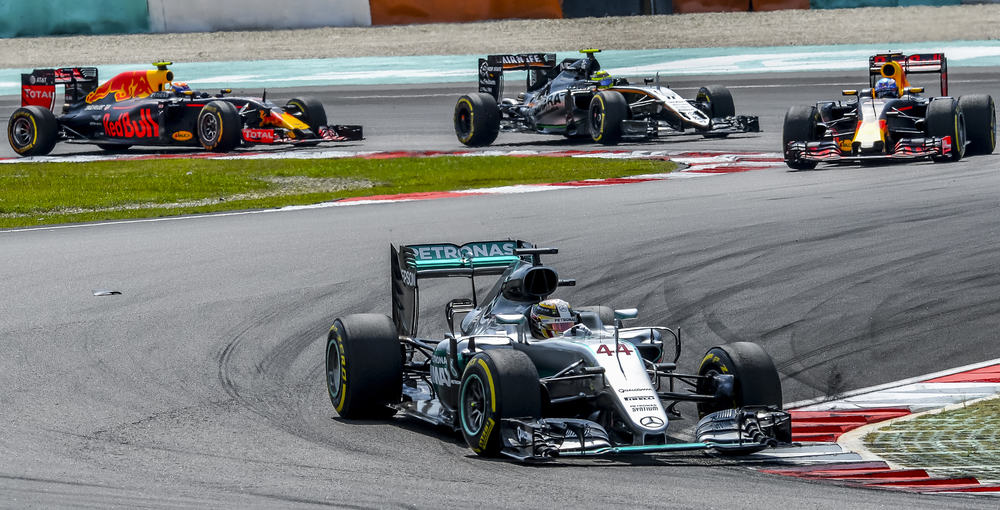
What Are Slipstream And Dirty Air In Formula 1?
In Formula 1, slipstreaming is a positive thing. As we have seen, due to the Coanda effect, Formula 1 cars generate a low-pressure zone behind them by redirecting the air. Therefore, in the straights, when a car follows another car closely, the air does not hit it as much since the car in front cuts it, generating that low-pressure zone so that the car behind can get a higher top speed with which to overtake.
The car in front, therefore, cuts the air, so in the straights, it is good for the car behind since the important thing is to reduce downforce to achieve a high-top speed. However, the opposite is true for cornering and braking; the important thing is to generate as much downforce as possible. Therefore, it is called dirty air in cornering, braking, and slipstreaming on straights.
The car in front is cutting through the air, so the car behind doesn’t get as much air, causing it to lose downforce, which means it won’t be able to take that corner as fast. Formula 1 cars are designed for laminar airflow. When cornering, the car in front generates a lot of turbulence that affects the cars behind, i.e., it causes dirty air and makes it more challenging to take the corner.
This affects especially the front tires since the front wing is the most sensitive, as it regenerates the airflow to the rest of the car. The rest of the aerodynamics will suffer if the front wing does not work well.
It also affects the cooling ducts of the brakes and engine, as well as the tires, since less air reaches them, and they overheat more. In the case of tires, overheating causes them to degrade much faster.
What Are The F1 2022 Aerodynamic Changes?
For the 2022 season, there was a significant change in the cars’ aerodynamics, as they became simpler, leaving behind the complex wings and side pods that characterized the cars of previous years. The new cars, much simpler aerodynamically, generate a large part of the downforce thanks to the return of the ground effect that was so famous during the 1970s and 1980s.
But why such drastic changes? The Formula, 1 cars of the last few years, were so aerodynamically complex that they generated a lot of turbulence, and were also very sensitive to it, making it very difficult to follow a car closely, as the closer you got to it, the more you noticed the loss of downforce.
Because of this, it became tough to overtake during the last years since a significant downforce was lost when approaching the driver in front. For this reason, on many occasions, the driver behind the other driver left a gap with him not losing downforce and not overheating the brakes or wearing out the tires more.
Thus, the objective of making the new cars much simpler aerodynamically is to favor that a car following another one does not lose as much downforce, facilitating overtaking and increasing the spectacle.
Have The F1 2022 Aerodynamic Changes Worked?
As we have seen, F1 changed the design of the cars for 2022 in an attempt to create closer wheel-to-wheel racing and reduce the impact of dirty air so that not as much downforce is lost when following, allowing for more overtaking. After one season with the new cars, have these changes really worked?
During the season, drivers showed a positive perception of the impact of the new regulations, believing that it had allowed for better on-track battles. However, this had not been backed up by official data until late in the season, when Pirelli, the category’s sole tire supplier, confirmed that overtaking compared to 2021 had increased by more than 30%.
While in 2021, Pirelli recorded 599 overtakes, in 2022, this figure increased to 785 over the same span of 22 races. It should be emphasized that only “real” overtakes were recorded, i.e., overtakes that occurred on track, and not overtakes by cars entering the pits or retiring.
These data are quite positive, even when compared to previous years, such as 2017, in which there were only 435 overtakes; 2018, in which there were 615; and 2019, in which there were 747. Moreover, Pirelli points out that the increase in overtaking was not only the only positive thing about the new regulations, but it was a very competitive year, especially in the midfield.
Therefore, the new regulations have perfectly fulfilled their objective. Moreover, this has only been the first year, so they have plenty of room for improvement and refinement.
Conclusion
The Coanda effect is one of the main physical phenomena considered when designing a Formula 1 car. Engineers spend a lot of time studying the behavior of the air to design a car that adapts to it as much as possible.
As a result, over the last few years, the cars became aerodynamically very complex, generating a lot of dirty air and causing the car behind to lose a lot of downforce. To avoid this, the FIA reduced the aerodynamic complexity of the cars to a large extent in 2022 and thus increased overtaking, which has seemed to have a positive effect.
References
- https://www.aerodinamicaf1.com/2019/09/efecto-coanda-y-drag-de-forma/
- https://www.youtube.com/watch?v=DTBxF_XLLMg
- https://es.motorsport.com/f1/news/efecto-coanda-prohibicion-formula1/4799999/#gal-4799999-m0-cambios-en-el-piso-del-red-bull-rb8-con-una-ranura-adicional-que-permite-el-paso-de-los-gases-
- https://www.gq.com.mx/deportes/articulo/que-es-el-tunel-de-viento-de-la-f1
- https://www.aerodinamicaf1.com/2019/11/la-simulacion-cfd-en-la-formula-1/
- https://www.formula1-dictionary.net/flow_viz_paint.html
- https://www.youtube.com/watch?v=TuHfiaQgu1U
- https://es.motorsport.com/f1/news/carga-aerodinamica-coches-2022-origen/7166634/
- https://www.gpfans.com/es/f1-noticias/96697/f1-pirelli-seala-aumento-del-30-en-los-adelantamientos-de-2021-a-2022/
- https://www.gpblog.com/en/news/52235/how-many-overtakes-were-completed-in-2019-compared-to-previous-years-.html

